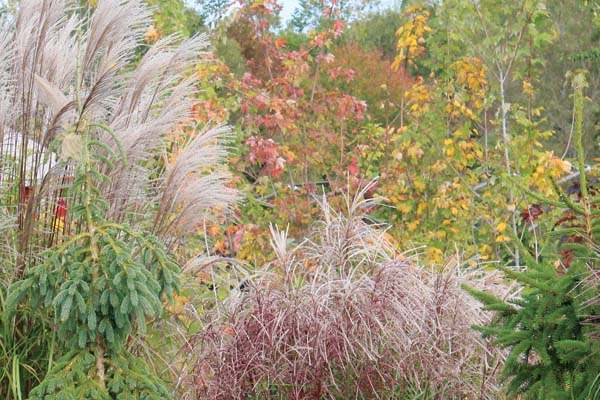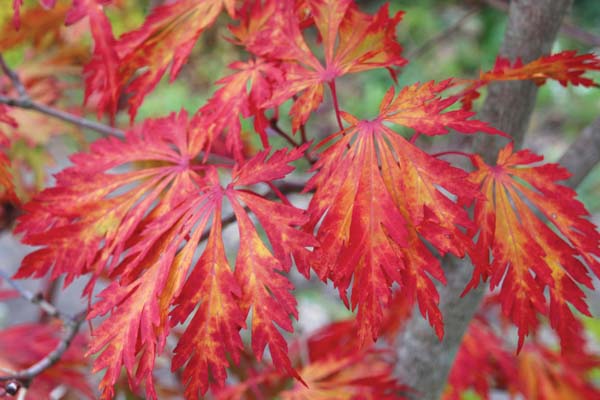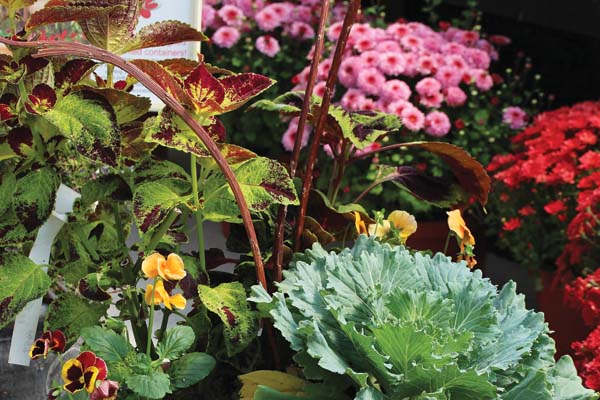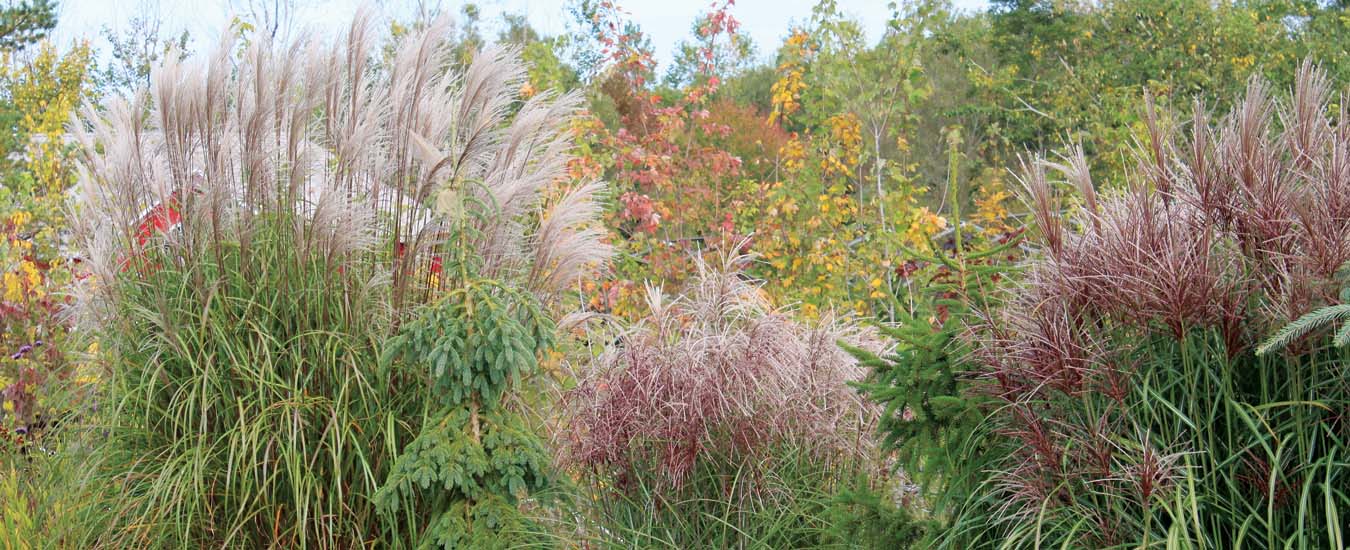Add plants now to finish the season in a blaze of glory—and have fresh salads, too!
Atlantic Canada often makes up for its less-than-welcoming springs with long, beautiful late summers and autumns. It’s a great time to work in the garden, as the summer heat and humidity give way to cooler air, and there are fewer insects to plague us as we work.
“Wait,” I hear some of you saying. “Working in the garden? In September and October? What could you possibly be doing, other than harvesting from the veggie garden and getting ready to plant bulbs? Isn’t planting season over?”
Well…no, it’s not, if you don’t want it to be. If you’re tired of planting, don’t worry: you certainly have my blessing to recline on a hammock and enjoy the view of your garden. If you are still haunting local nurseries and making space to plant new items, then this season and this article are for you. I’ve long been a proponent of the mantra, “just keep planting,” meaning if you can get a shovel in the ground (assuming it’s not frozen or covered in snow), you can plant many things—perennials, shrubs, trees, some cool-season vegetables—because late season is actually a great time for gardening.

Perennial grasses like these Miscanthus varieties put on a great late season show.
Pleasant planting conditions
Why would you plant in September and October? There are a few good reasons:
- Generally, the weather is warm in the day, cooler at night, which is pretty much ideal growing weather for new plants. After the heat of high summer, we gardeners appreciate such pleasant days to pull us away from our work and get us involved in our favourite avocation. There are no blackflies and very few (if any) mosquitos to contend with, either!
- There is more moisture from rainfall, a particular benefit if it’s been a long, hot summer and you have had to water your garden on a regular basis. Newly transplanted trees, shrubs and perennials must have regular watering—not just once after planting, but faithfully on as much as a daily basis, depending on the weather, to help their root systems expand and settle before winter arrives.
- For the thrifty, you’ll often find bargains on plants as the season winds down. Nurseries like to reduce their stock inventories so that they don’t have to overwinter everything in containers, which is a complex and time-consuming job for them. There is a caveat to this—make sure any plant you’re considering is just languishing from being pot-bound and isn’t badly broken, nor plagued by a disease or pest which it can transfer to your healthy plants.
- If you love cool-season crops, primarily salad greens and table greens, you can plant seed and enjoy fresh greens until freeze-up.
- You’ve been to visit other private and public gardens this summer and have been inspired by hardscaping, plants and planting ideas that you’d like to try for yourself, and you want to get them in and establishing now for next year.
- You’ve decided that you need to add some plants for fall and winter interest. I will grant that last winter, we all had so much snow that there was no way to even see the garden, let alone enjoy the look of seedheads on perennials or the colour and structure of shrubs. About the only thing I could see beyond the snowdrifts were the trees in my yard. Under normal winter conditions, however, we have less snowfall and can enjoy the fourth garden season very nicely.
“Scruffing up the roots”
It is easy for plants in small containers to have become rootbound by the latter part of the summer. You can easily tell something is rootbound because the rootball will be a mass of roots, twisting round and round in the pot, maybe even growing out the bottom of the pot. Happily, when you go to plant your new acquisition, you can rectify the situation by root pruning, or as a friend of mine calls it, “scruffing up the roots.” It sounds scary to go at the roots of a plant with secateurs or a knife, but the plant will be better for this experience. You can first try to loosen the roots with a stream of water from a hose, but if that doesn’t help, just cut through the sides and bottom of the root ball with a sharp knife, pruning saw or your secateurs. You don’t have to cut too deeply, and if you’re brave you can remove some of the bottom root mass where it was against the container. Then plant as you would any other specimen, water it in well, and be patient. The pruning will stimulate new roots to grow out and away in the soil, anchoring your plant.

Japanese maples are treasured for their foliage, especially as autumn unfolds.
Blaze of glory
Those who have been faithful readers of Saltscapes know I have a deep love for colourful foliage. Most plants don’t bloom continuously, but those that have foliage of different hues—blue-green, yellow, burgundy, variegated in assorted shades—tend to look wonderful whether they’re flowering or not. I just helped a dear friend plant a new garden this summer, and included numerous perennials with blue-green or grey-green foliage. The result has been quite fabulous.
Of course, we are now heading into the season when hardwood trees turn incandescent shades of yellow, bronze, scarlet and copper. Many perennials and shrubs also change colour with the season, including those that normally have differently-hued foliage. One of the best examples of great fall colour comes from Japanese maples (Acer palmatum), which, depending on the variety, can have finely-dissected, lacy foliage as well as more obviously maple-like leaves. Many of these maples have red, burgundy, gold or variegated foliage all growing season, and then in autumn they really turn on the hues. Japanese maples are not suitable for the colder parts of the region, but many of us can and do enjoy them in our gardens. (See sidebar on page 88 for some excellent plants for fall colour.)
Salad days
One of the best things about gardening is the chance to learn something new, and it doesn’t matter if you’ve been gardening for years or are a newbie—there is always something new and fascinating to learn. I learned this spring, for example, that newly sprouted pea plants are absolutely delicious in salads or on sandwiches! I had eaten pea shoots before, but I was visiting Lloyd Mapplebeck of Hillendale Perennials near Truro this spring and he showed me pots of sprouted pea greens. Naturally, I took a pot home, and enjoyed adding the greens to my meals for at least a month before they got too big and began flowering. Then I savoured a few peas before consigning the pot to the compost.
I don’t have a vegetable garden but do have large pots of salad greens, cilantro, basil and purple mizuna growing on my deck, and expect to be harvesting from them until frost hits. With any luck I will have made all the basil into pesto before frost arrives.
Bulbs for a fall planting finale
Once frost hits and things stop flowering, you can clean up the annuals and containers and put next spring’s promise into the ground: flowering bulbs! If you’re plagued by deer eating your tulips, try planting them in large, frost-resistant containers that you can put on your deck or steps; otherwise, choose deer-resistant species such as flowering onions (alliums), fritillaria, daffodils, snowdrops and muscari. Just remember when planting bulbs to put them in groups of three, five, seven or other odd-numbered amount—never in straight rows or in even numbers. You’ll get a much better bang for your bulb-buck.
It’s not cheating…
…to purchase autumn containers of chrysanthemums, flowering cabbage and kale, grasses or asters. These fall performers will decorate any dooryard and gladden your heart before the coming of November. They can even look wonderful with a little frost, ice or snow on them—but we are going to hope for a mild winter after last year.

Late-season planters feature succulents, annuals such as pansies and flowering kale, and coleus for more colour; many hydrangeas are rebloomers right until frost.
Foliage for fall
Fothergilla: If you don’t have a spring-flowering fothergilla, you need to add this shrub to your garden. Fragrant spikes of white flowers in spring, blazing fall colour…what’s not to love?
Highbush blueberry: Those who enjoy growing blueberries in their gardens not only get to enjoy fresh fruit, but an added benefit—brilliant autumn foliage.
Hydrangea: Although we think of these plants primarily for their showy flowers (many of which continue well into autumn), some hydrangeas have great fall colour too, including the oak leaf hydrangeas and paniculata (peegee-type) varieties such as ‘Quickfire’.
Rugosa rose: The toughest of roses not only is fragrant and floriferous, it produces brilliant red, edible rosehips and its foliage turns fascinating colours as fall progresses.
Ninebark (Physocarpus): Ninebarks are one of my favourite shrubs because they offer four-season interest. Many have colourful foliage all season that changes hues in autumn. Try ‘Diablo’, ‘Coppertina’, or ‘Amber Jubilee’.
Ornamental grasses: Some of our popular ornamental grasses don’t start blooming until late summer and early fall, and have great foliage tints as well. Look for Panicum ‘Heavy Metal’ or ‘Dallas Blues’ (blue-green foliage) or red tipped ‘Shenandoah’ among the panic grasses; Miscanthus purpurascens, or purple flame grass, has spectacular fall colour as well as plume like flowers; little bluestem (Schizachyrium scoparium) is a blue tinted grass that turns red and purple hues as the weather gets colder.
Viburnum: Many of the viburnums have great fall colour as well as brightly-hued berries. Some are native, some introduced, so hardiness can vary, but your local nursery can match you to the right choice for your garden.
Virginia creeper: For the vertical-gardening enthusiasts among us, this tough vine puts on a dazzling show of red foliage come fall.
Witch hazel (Hamamelis): Native Hamamelis virginiana blooms in the autumn, and while its flowers are not showy, its fragrance is lovely; its foliage turns brilliant hues as well. The winter and spring-flowering hybrids also have fabulous fall colour, and that early bloom in late winter will cheer even the most winter-loathing heart.
Evergreens: Whether you enjoy growing broadleaf evergreens like holly and rhododendrons or coniferous evergreens, these plants are stars all season long. We could devote the whole magazine to singing the praises, especially since many change colour as they go into fall and winter. Personal favourites include the dawn redwood (Metasequoia), ‘Sunkist’ arborvitae (Thuja), weeping false cypress (Chamaecyparis), any blue spruce, and Siberian cypress (Microbiota), which turns bronze-purple in winter.
